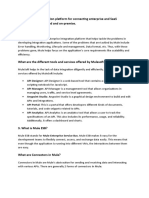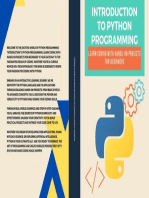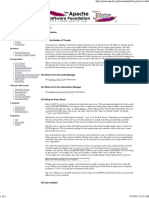How to Learn Python
Uploaded by
markgilabayon790How to Learn Python
Uploaded by
markgilabayon790Learning Python can be a rewarding journey, whether you're a beginner or have some
programming experience. Here's a step-by-step process to help you get started with
Python:
Step 1: Understand Why You Want to Learn Python
Before diving into learning Python, it's important to identify your goals and
reasons for learning it. Are you interested in web development, data analysis,
machine learning, or something else? Knowing your purpose will guide your learning
path.
Step 2: Install Python
If Python is not already installed on your computer, download and install the
latest version from the official Python website
(https://www.python.org/downloads/). Ensure you select the appropriate version for
your operating system (e.g., Windows, macOS, Linux).
Step 3: Choose a Development Environment
Select a code editor or integrated development environment (IDE) to write and run
Python code. Some popular options include Visual Studio Code, PyCharm, Jupyter
Notebook, and IDLE (comes bundled with Python).
Step 4: Learn the Basics
Start with the fundamentals of Python:
Variables and Data Types: Learn how to declare variables and understand data types
like integers, floats, strings, and booleans.
Basic Operations: Explore arithmetic operations, string manipulation, and
comparison operators.
Control Structures: Understand if statements, loops (for and while), and
conditional statements (e.g., if-else).
Functions: Learn how to define and call functions in Python.
Lists and Dictionaries: Explore data structures like lists and dictionaries.
Step 5: Practice Writing Code
The key to mastering Python is practice. Write simple programs and scripts to
reinforce your understanding of the basics. Start with small projects and gradually
work your way up to more complex tasks.
Step 6: Explore Python Libraries
Depending on your interests, explore Python libraries and frameworks that are
relevant to your goals. For example:
Web Development: Learn Flask or Django for building web applications.
Data Analysis: Study libraries like NumPy, pandas, and Matplotlib.
Machine Learning: Begin with scikit-learn and TensorFlow or PyTorch for deep
learning.
Step 7: Read Documentation and Tutorials
Python has excellent documentation and a vast online community. Consult the
official Python documentation (https://docs.python.org/), and search for tutorials
and guides on websites, forums, and blogs. Websites like Stack Overflow can be
valuable for troubleshooting and learning from others.
Step 8: Work on Real Projects
Apply your knowledge by working on real projects. Start with small, achievable
tasks and gradually take on more significant challenges. Building projects will
solidify your skills and provide a portfolio for future opportunities.
Step 9: Join Python Communities
Engage with the Python community by joining forums, attending local meetups or
online events, and participating in open-source projects. Collaboration and
networking can accelerate your learning.
Step 10: Keep Learning and Stay Updated
Python is a dynamic language with continuous updates and improvements. Stay current
by reading blogs, books, and attending workshops or online courses to deepen your
Python skills.
Remember that learning Python is a journey, and progress may be slow at times. Be
patient, persistent, and enjoy the
You might also like
- Python: For Beginners A Crash Course Guide To Learn Python in 1 WeekFrom EverandPython: For Beginners A Crash Course Guide To Learn Python in 1 Week4/5 (25)
- Easy-To-Follow Tutorial To Learn Python Programming In Less Than One WeekFrom EverandEasy-To-Follow Tutorial To Learn Python Programming In Less Than One Week3/5 (6)
- Mulesoft Is An Integration Platform For Connecting Enterprise and Saas Applications in The Cloud and On-Premise. What Is Mule?No ratings yetMulesoft Is An Integration Platform For Connecting Enterprise and Saas Applications in The Cloud and On-Premise. What Is Mule?8 pages
- Python for Everyone: A Complete Guide to Coding, Data, and Web Development: Your Guide to the Digital World, #3From EverandPython for Everyone: A Complete Guide to Coding, Data, and Web Development: Your Guide to the Digital World, #3No ratings yet
- Python Simplified: Learn Programming Through Practical ExamplesFrom EverandPython Simplified: Learn Programming Through Practical ExamplesNo ratings yet
- Python Programming: A Hands-On Guide: Hello World E-books STEM, #1From EverandPython Programming: A Hands-On Guide: Hello World E-books STEM, #1No ratings yet
- Learn Python Programming for Beginners: The Best Step-by-Step Guide for Coding with Python, Great for Kids and Adults. Includes Practical Exercises on Data Analysis, Machine Learning and More.From EverandLearn Python Programming for Beginners: The Best Step-by-Step Guide for Coding with Python, Great for Kids and Adults. Includes Practical Exercises on Data Analysis, Machine Learning and More.4/5 (2)
- Python Programming Illustrated For Beginners & Intermediates“Learn By Doing” Approach-Step By Step Ultimate Guide To Mastering Python: The Future Is Here!From EverandPython Programming Illustrated For Beginners & Intermediates“Learn By Doing” Approach-Step By Step Ultimate Guide To Mastering Python: The Future Is Here!3/5 (1)
- Python Programming Illustrated For Beginners & Intermediates: “Learn By Doing” Approach-Step By Step Ultimate Guide To Mastering Python: The Future Is Here!: The Future Is Here!From EverandPython Programming Illustrated For Beginners & Intermediates: “Learn By Doing” Approach-Step By Step Ultimate Guide To Mastering Python: The Future Is Here!: The Future Is Here!4/5 (2)
- Introduction to Python Programming: Learn Coding with Hands-On Projects for BeginnersFrom EverandIntroduction to Python Programming: Learn Coding with Hands-On Projects for BeginnersNo ratings yet
- 10 Simple Steps To Learn Python ProgrammingNo ratings yet10 Simple Steps To Learn Python Programming2 pages
- Mastering Python: Learn Python Step-by-Step with Practical ProjectsFrom EverandMastering Python: Learn Python Step-by-Step with Practical ProjectsNo ratings yet
- A Comprehensive Guide to Learning Python for Year 10 StudentsNo ratings yetA Comprehensive Guide to Learning Python for Year 10 Students4 pages
- The Python Bible For Beginners 1724508132No ratings yetThe Python Bible For Beginners 1724508132186 pages
- Flask Blueprints: Dive into the world of the Flask microframework to develop an array of web applicationsFrom EverandFlask Blueprints: Dive into the world of the Flask microframework to develop an array of web applicationsNo ratings yet
- 7 Beginner To Python Pro - Your Guide On How To Become A Python Developer - TAKEONo ratings yet7 Beginner To Python Pro - Your Guide On How To Become A Python Developer - TAKEO3 pages
- 6 Essential Steps To Learn Python Effectively in 2025No ratings yet6 Essential Steps To Learn Python Effectively in 20257 pages
- Python for Beginners: The Dummies' Guide to Learn Python Programming. A Practical Reference with Exercises for Newbies and Advanced Developers: Python Programming, #1From EverandPython for Beginners: The Dummies' Guide to Learn Python Programming. A Practical Reference with Exercises for Newbies and Advanced Developers: Python Programming, #1No ratings yet
- Learn Python in A Weekend - Córcoles, Sheila - Moreno, AlfredoNo ratings yetLearn Python in A Weekend - Córcoles, Sheila - Moreno, Alfredo142 pages
- Python Programming for Kids: Fun and Easy Guide to Building Your First ProgramsFrom EverandPython Programming for Kids: Fun and Easy Guide to Building Your First ProgramsNo ratings yet
- IBM DOORS Tutorial Systems Engineering Tutorial100% (1)IBM DOORS Tutorial Systems Engineering Tutorial128 pages
- RITM0096935 - CEE - ZF110 SP GL Indicator Substitution - CombinedNo ratings yetRITM0096935 - CEE - ZF110 SP GL Indicator Substitution - Combined6 pages
- WINDOWS 10 Course Notes: Windows 10 Is A Series ofNo ratings yetWINDOWS 10 Course Notes: Windows 10 Is A Series of11 pages
- Procedure For Installing Service Manual Viewer and Service Manual DataNo ratings yetProcedure For Installing Service Manual Viewer and Service Manual Data28 pages
- Hardware Abstraction Layer (Hal) Module of Motorware: User InterfaceNo ratings yetHardware Abstraction Layer (Hal) Module of Motorware: User Interface42 pages
- Java - A Step-by-Step Guide for Absolute BeginnersNo ratings yetJava - A Step-by-Step Guide for Absolute Beginners183 pages
- Apache JMeter - User's Manual - Best Practices-17 PDFNo ratings yetApache JMeter - User's Manual - Best Practices-17 PDF4 pages
- Introduction To Unix: Unit 2:the File System and Some File Handling CommandsNo ratings yetIntroduction To Unix: Unit 2:the File System and Some File Handling Commands62 pages
- CO - IF - 22412 - CO1: Date: 05 February 2021 Learning at Your DoorstepNo ratings yetCO - IF - 22412 - CO1: Date: 05 February 2021 Learning at Your Doorstep14 pages

























































































